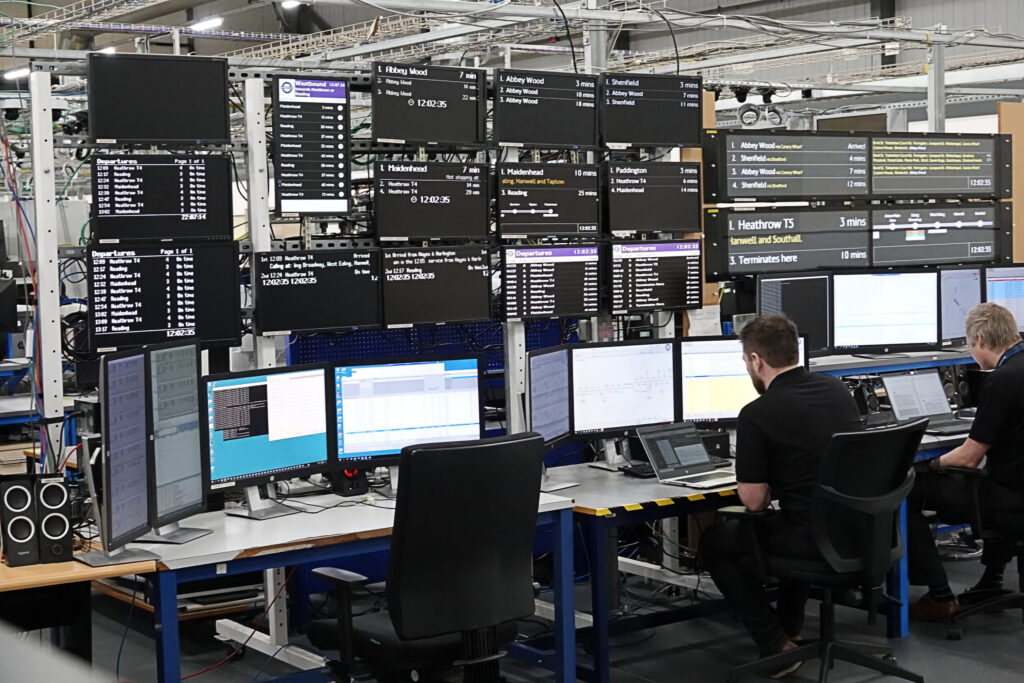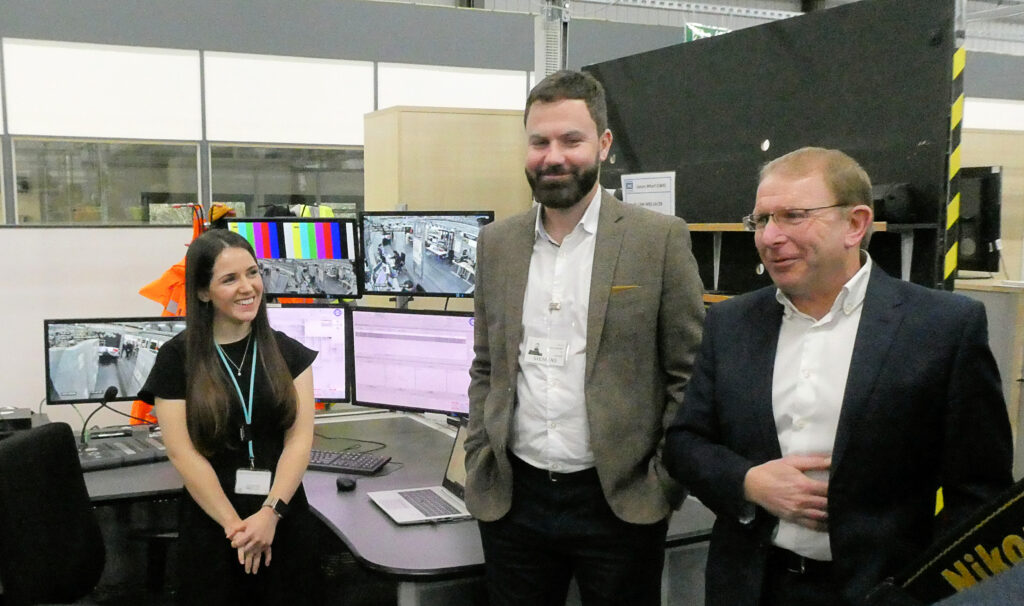HS2 is building four stations, which will be huge, even if Euston ends up only with six platforms. Old Oak Common is underground and, if the plans for over-site development go ahead, Euston will be underground too. Interchange and Birmingham Curzon Street will be on what will amount to extensive bridges. It’s no exaggeration to say that even non-public spaces at these stations will be larger than many older stations’ public spaces. As a result, there will be many systems to control and HS2 took an early decision that the same integrated information management and control system will be used for all four stations.
In mid-January 2024, at an event at the Siemens Mobility facility in Ashby-de-la-Zouch hosted by Rob Morris Joint CEO Siemens Mobility UK and Managing Director for Rail Infrastructure and Software, it was announced that HS2 had placed a contract valued at £47 million with Siemens. This is a framework contract that will be called off by the main contractor joint ventures building each station.
Paul Tomkinson, HS2 Head of Stations Contracts Integration, explained that this approach will be used for other station systems that HS2 require to be common, such as lifts and escalators, LV power, and uninterruptable power supplies.

The technology to be used is Siemens Mobility’s Digital Station Manager technology platform which is already in use on London’s Elizabeth line and which will “touch every stage of passengers’ journeys though the stations”. It will provide the Station Information Management System (SIMS) controlling systems such as lighting, fire, energy management, ventilation, platform barrier systems (at the through platforms), security (e.g. CCTV and intruder detection), and the Customer Information System (CIMS) controlling public address and feeds to audio and visual systems, although it was made clear that the contract for the visual display screens is being completed separately.
A factory tour
The Ashby-de-la-Zouch site is Siemens’ UK HQ for Communication and Information Systems (C&IS) although the team works very closely with colleagues at its signalling HQ in Chippenham. A tour of the factory was led by Colin Rowcliffe, operations director for C&IS and Julian Randle, HS2 delivery lead.
They demonstrated a replica of the equipment installed at the Elizabeth line’s Romford operations centre and at each of the underground stations. They explained that Siemens will maintain this replica for the life of the system and continue to support TfL with enhancements brought about by the experience of operating the railway, enabling any system issues at site to be replicated and investigated. Enhancements include: messages to try and encourage customers seeking Heathrow T4 or T5 to catch the first train going to Heathrow, changing at Terminal 2, 3 stations if necessary, to providing more information about station stopping patterns especially on the western section because it is unusual that metro style services do not call at all stations.
A typical operator’s workstation has three monitors, a keyboard and mouse, as well as a telephone terminal with handsets. Two of the monitors show graphical information which might be the line diagram showing where all the trains are located or a graphical information system (GIS) representation of a station. In each case the operator can zoom, scroll, and change layers to access more information or move around the (virtual) levels of the station. The third screen contains a text log of events, the seriousness of which is highlighted by colour. During the demonstration, an alarm was created which immediately appeared on the third screen. The operator was then able to locate the alarm on the GIS. Operators are able to access any of the 2,000 or so CCTV cameras remotely, and all are recorded locally.
The replica system is a normal feature of telecoms control systems and visitors saw other replicas in use. They allow staff in the factory to analyse issues reported from the field and test fixes.
Asked about remote connections and uploading software patches from Ashby-de-la-Zouch, Siemens’ engineers said that the replica is entirely separate and that they visit customers’ premises to carry out updates. For the Elizabeth line, as an example, engineers visit Romford and from there can update the operations centre system and each of the stations.

The equipment being assembled appeared to this mechanical engineer to be largely standard IT racks, modules, brackets, and displays brought in from Siemens’ 3,000 suppliers, 47% of which are UK based SMEs. Some specialised equipment has to be manufactured and although Siemens outsources metal fabrication, it carries out assembly in house or, for large production runs, builds the prototype in house and has the production modules manufactured at the Chippenham factory.
In a conversation about physical interface, Julian said that he is expecting the amount of on-site inspection and measurement, prior to manufacture and fit out, to be reduced because of HS2’s commitment to, and quality of, its building information management (BIM) system. He acknowledged that some visits will be necessary but not as often as was the case on previous jobs.
It is the software – configuration of standard software and development of bespoke elements – that brings all this to life. Many of the functions are safety critical (for example, if a power system has to be isolated remotely the operator must be confident that the isolation has happened) and it is therefore important that proper processes and tools are employed. Siemens’ role is to apply/develop control system software and throughout the tour the comment was heard: “Tools [and processes] are of paramount importance but are only as good as the people.”
People
With 3,000 suppliers, and a contract such as HS2’s where there are effectively five clients (HS2, each station JV, and possibly route-based signalling and SCADA systems) collaboration is vital. Rob said that he speaks with Howard Smith, TfL’s Elizabeth line director, on a weekly basis to ensure that Howard is getting what he needs from Siemens. Rob said that this type of collaborative relationship is replicated throughout the organisation.
Rail Engineer observed that the people seen on site were generally relatively young. Rob said that when he started with Siemens eight years ago, the demographic was quite different and younger people had to be brought in to avoid what might have led to a loss of skills as older team members retired. Colin Rowcliffe said that the Ashby-de-la-Zouch site employs about 300 people of whom over 10% are trainees, and many more are employed on installation and configuration at customer sites.

Julian added that he tries to populate project teams with a mix of experience levels especially for long term projects that ultimately lead to long-term operational support contracts. It would be unfortunate, for example, if all the members of a project team were experienced people who retired shortly after the end of the project – not good for ongoing support.
Rob echoed these comments citing Siemens’ commitment to railway engineering skills through, for example, the National Training Academy for Rail based adjacent to Siemens rolling stock depot in Northampton.
Asked about the future, Rob talked about an ever more competent workforce that would increasingly use software and would reflect the community. He thought that there would continue to be a skills shortage and hoped that tools such as artificial intelligence might help with routine software production, allowing humans to concentrate on complex and innovative tasks. He also forecasted that interlockings might be on computers hosted in data centres (i.e., in the cloud) rather than lineside. He is keen to find ways to reduce the amount of active lineside kit.
No doubt, Rail Engineer will return to this project as it progresses.
Image credit: Siemens / Malcolm Dobell


